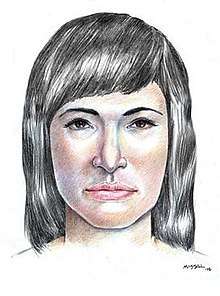Isdal Woman
| Isdal woman | |
|---|---|
 2016 sketch by forensic artist Stephen Missal | |
| Born |
c. 1930s[1] Unknown, (most likely Southeast Germany near Nuremberg[1]) |
| Status | Unidentified for 47 years, 10 months and 20 days |
| Cause of death | Combination of carbon monoxide poisoning and barbiturate overdose[2] |
| Body discovered |
29 November 1970 Isdalen Valley, Bergen, Norway |
| Resting place | Møllendal cemetery, Bergen |
| Known for | Mysterious death |
| Height | 164 cm (5 ft 5 in) |
The Isdal Woman (Norwegian: Isdalskvinnen) is the name given to an unidentified woman who was found dead at Isdalen Valley in Bergen, Norway, on 29 November 1970. Considered one of Norway's most profound mysteries, the case has been the subject of intense speculation for many years.[3]
Discovery
On the afternoon of 29 November 1970, Prof. Ørjar Øyen and his two daughters were hiking in the foothills of the north face of Mount Ulriken, in an area known as the Isdalen Valley. They found the partially-charred body of a woman, hidden among some rocks, in an area popularly known as "Death Valley". Also found (confirmed during the autopsy) were a dozen phenobarbital sleeping pills (brand name Fenemal); an empty bottle of St. Hallvard likør (at times labelled St. Hallvard liqueur); two partially charred plastic water-carrying bottles; an almost fully burned plastic container; remnants of rubber boots; a scarf and an umbrella; a watch with two earrings and a ring. Beneath the body was a fur hat which was later found to have contained a small trace of petrol.[4]
Forensic data
An autopsy concluded the woman died from poisoning by Fenemal and carbon monoxide.[5] Analysis of her blood showed she had consumed at least 50 sleeping pills.[6] Her face had been burned and was unrecognisable. Her neck was bruised, possibly by a blow.
Radiocarbon dating in 2017 indicated that the woman had been born in about 1930 in or near Nuremberg, Germany, but had moved to France or the German-French border region as a child.[1][7] This reinforced earlier analysis of her handwriting, which suggested that she had been educated in France or a neighbouring country. A DNA profile was obtained in 2016 from the woman's teeth, and this suggested ancestral ties to western Continental Europe.[5]
Analysis of the woman's teeth also indicated she had been to a dentist in East Asia, Central Europe, Southern Europe or South America.[8][9]
Investigation
Police immediately launched a full-scale investigation. Composite sketches, based on witness descriptions and analysis of her body, were published in the Norwegian media and circulated in many countries via INTERPOL.
They found two suitcases belonging to the woman at an NSB railway station in Bergen. In the lining of one, police discovered 500 Deutsche Mark. Among other things, they found clothing (all identifying labels removed), a lotion prescription (doctor's name and date removed), 130 Norwegian kroner, spoons similar to the one found melted at the Isdalen Valley site,[10] a pair of sunglasses carrying partial fingerprints[11] and some diary entries. Police later concluded the entries were coded dates and places the woman had visited.[12] An unusual dress was found as well; from that, police determined the woman had a somewhat provocative style, marked by Italian taste.
An Italian photographer's postcard was found in the woman's luggage. When police spoke with him, he said he had given a similar woman a lift to Hotel Alexandra in Loen. He said he also had dinner with her. The woman told him she was from a small town north of Johannesburg, South Africa, and she had six months to see Norway's most beautiful places. The police checked the woman the photographer named in South Africa - and she was not reported missing. Thus this line of inquiry went nowhere.
Police learned "Isdal Woman" had traveled around Norway and Europe with at least eight false passports. While authorities eventually concluded she had committed suicide,[3] others believe there is evidence that she was murdered.[13]
The last time she was seen alive was when she left room 407 of the Hotel Hordaheimen on 23 November 1970. She paid cash and then got into a taxi. The hotel staff described her as between the ages of 30 and 40, a smoker, about 164 cm tall, with wide hips, small eyes, and a pleasing figure. She mostly stayed in her room and seemed to be on guard.
The taxi driver who took her from the hotel to the station was never found. Just as we never knew how she got to the isolated place where her body was discovered. Hikers to comment on the topic remained unclear. In 1991 a taxi driver wishing to remain anonymous said that after taking the unknown to the hotel, they were joined by another man before the station.[14]
Multiple investigations point to the possibility that she was a spy.[15]
Theories

Despite the significant police resources deployed, the unknown was never identified. Many questions remain unanswered, especially about the reasons for such an adventurous existence with so many different moves and identities.
A theory involving fake check trafficking was proposed by a retired police officer but quickly abandoned.
The most frequently cited theory is that of espionage in the Cold War context of the time. The possession of nine fake passports seems indeed to imply a very professional organization.[16] The declassified records of the Norwegian National Defense bring disturbing coincidences: many of the stranger's movements seem to correspond to top secret trials of the Norwegian Penguin missile. A fisherman even said to have recognized the unknown by observing military movements in Stavanger.[17] Yet the conclusion of the local police remains that of suicide by ingestion of sleeping pills. Given the doubts raised by this finding, the local police were also suspected of involvement in this case. Norway has also experienced other strange disappearances in 1960-1970 years, close to military installations, which also evokes the track of international espionage.[18]
Witness descriptions and itinerary
People who saw or met the woman said she wore wigs (which was quite common practice in this period[19]) and spoke French, German and broken English.[20] She had stayed at several hotels in Bergen, and repeatedly changed rooms after checking in.[21] She told hotel staff she was a travelling saleswoman and antiquities dealer. At several places, she left a standing order: porridge with milk.
One witness said she overheard the woman talking to a man in a Bergen hotel. According to the witness, the woman said, "Ich komme bald" (German: "I am coming soon").
The last hotel the Isdal Woman stayed at was the Hotel Hordaheimen (room 407, November 19–23). Staff told police she was good-looking and roughly 5-feet-4-inches tall, with dark brown hair and small brown eyes. According to dental examination in 2017, she is estimated to have been around 40 yrs of age at the time of her death.[22] Another Hordaheimen guest told police the Isdal Woman smoked South State cigarettes (a Norwegian brand). Staff noted the woman kept mainly to her room and seemed to be on guard. When she checked out of the Hordaheimen on 23 November, Isdal Woman paid her bill in cash and requested a taxi. Her whereabouts between then and 29 November (when her body was found) are unknown.
On the 5th of February 1971 the Isdal Woman was given a Catholic burial, in an unmarked grave, and in a zinc coffin to preserve her remains.
Later developments
In 2002, Tore Osland, son of leading investigator, wrote the book "Isdalskvinnen, Operation Isptopsy."[23]
In 2005, a Bergen resident who was 26 in 1970 told a local newspaper that after seeing the sketch circulated, he had suspected the dead woman was the woman he had seen five days before the body was found, when he was hiking on the hillside at Fløyen. She was dressed lightly, for the city rather than a hike, and was with two men wearing coats who looked "southern". She seemed about to say something but they stopped her. He went to someone he knew at the police to report this, but was told to forget about it.[24] Therefore neither his name nor his alleged sighting was recorded anywhere back then.
In 2016, NRK commissioned the American artist Stephen Missal to create six alternative sketches of the Isdal Woman, which were put before people who had seen her.[25]
See also
References
- 1 2 3 Hansen, Ståle. "Tennene avslører: Isdalskvinnen eldre enn man trodde". NRK. Retrieved 9 January 2018.
- ↑ Cheung, Helier. "Isdal Woman: The mystery death haunting Norway for 46 years". BBC. Retrieved 13 May 2017.
- 1 2 Tønder, Finn Bjørn (26 November 2002). "Viktig nyhet om Isdalskvinnen" [Important news about Isdal Woman]. Bergens Tidende (in Norwegian). Retrieved 21 October 2012.
- ↑ "Timeline - The Palace of the Ice Valley - Special".
- 1 2 "The Isdalen Mystery". NRK. Retrieved 13 December 2016.
- ↑ "The Isdal Woman – Futility Closet".
- ↑ "'Major breakthrough' in Norway's 46-year-old Isdal woman mystery". BBC. 19 May 2017. Retrieved 19 May 2017.
- ↑ "Do you remember this woman?". NRK. 29 November 2016. Retrieved 13 May 2017.
This is the description the Norwegian police sent to Interpol and police forces throughout Europe, North Africa and the Middle East: 'Approximately 25-30 years of age. Height 164 cm, slim with broad hips. Long brownish-black hair, small round face, brown eyes, small ears. The teeth showed many repairs, several of the molars had gold caps, and the dental work is of a kind practised in the Far East, Central or Southern Europe, and South America. Fourteen of the teeth are partly or completely root-filled. There is a marked partition between the two upper front teeth'
- ↑ Yndestad, Monika Nordland. "Hær bæres Isdalskvinnen til sitt anonyme gravsted" [Here Isdal Woman is carried to her anonymous grave]. Bergensavisen (in Norwegian). Retrieved 21 October 2012.
- ↑ "Isdal Woman Case". The Doe Network. Retrieved 4 December 2016.
- ↑ "Gåten i Isdalen". nrk.no.
- ↑ "Kalde spor fra Isdalen" [Cold trail from Isdalen]. A-magasinet (in Norwegian). 19 November 2010.
- ↑ "If You're Never Heard Of The Case Of The Isdal Woman, It's One Of The Most Odd Cases You'll Ever See". BuzzFeed. Retrieved 2018-04-25.
- ↑ Hansen, Ståle. "Sporene politiet aldri fant ut av".
- ↑ Cheung, Helier (2017-05-13). "The mystery death haunting Norway for 46 years". BBC News. Retrieved 2018-04-11.
- ↑ Hansen, Ståle. "The Isdalen mystery".
- ↑ Hansen, Ståle. "Her er den hemmelige Isdals-mappen".
- ↑ Hansen, Ståle. "De kom til Norge og døde".
- ↑ "Women's 1960s Hairstyles: An Overview - Hair and Makeup Artist Handbook". 12 March 2012.
- ↑ "Norway makes international appeal to solve 46-year-old mystery". TheLocal. Retrieved 1 July 2018.
- ↑ "Slo bensin over seg og tende på". NRK. Retrieved 23 October 2016.
- ↑ "Isdal woman older than previously thought". NRK. Retrieved 1 July 2018.
- ↑ "Isdalskvinnen". Retrieved 9 March 2018.
- ↑ Yndestad, Monica Nordland (20 March 2005). "Turgåer møtte isdalskvinnen" [Hiker met Isdal Woman]. Bergensavisen (in Norwegian). Retrieved 22 May 2017.
Glem henne, hun ble ekspedert. Saken blir aldri oppklart [Forget her, she's been seen to. The case won't ever be solved]
. - ↑ Aardal, Eirin (20 October 2016). "Er dette Isdalskvinna?" [Is This Isdal Woman?] (in Norwegian). NRK. Retrieved 22 May 2017.
Further reading
- Osland, Tore; Operasjon Isotopsy, Bergen 2002 ISBN 9788299656412
- Isdal Woman at The Doe Network